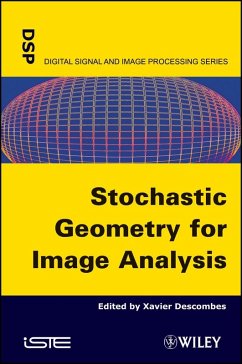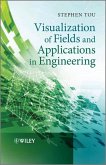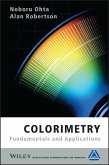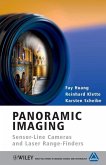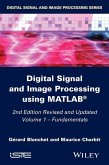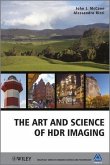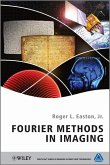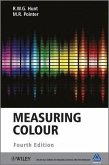Stochastic Geometry for Image Analysis (eBook, PDF)
Redaktion: Descombes, Xavier
144,99 €
144,99 €
inkl. MwSt.
Sofort per Download lieferbar

0 °P sammeln
144,99 €
Als Download kaufen

144,99 €
inkl. MwSt.
Sofort per Download lieferbar

0 °P sammeln
Jetzt verschenken
Alle Infos zum eBook verschenken
144,99 €
inkl. MwSt.
Sofort per Download lieferbar
Alle Infos zum eBook verschenken

0 °P sammeln
Stochastic Geometry for Image Analysis (eBook, PDF)
Redaktion: Descombes, Xavier
- Format: PDF
- Merkliste
- Auf die Merkliste
- Bewerten Bewerten
- Teilen
- Produkt teilen
- Produkterinnerung
- Produkterinnerung

Bitte loggen Sie sich zunächst in Ihr Kundenkonto ein oder registrieren Sie sich bei
bücher.de, um das eBook-Abo tolino select nutzen zu können.
Hier können Sie sich einloggen
Hier können Sie sich einloggen
Sie sind bereits eingeloggt. Klicken Sie auf 2. tolino select Abo, um fortzufahren.

Bitte loggen Sie sich zunächst in Ihr Kundenkonto ein oder registrieren Sie sich bei bücher.de, um das eBook-Abo tolino select nutzen zu können.
This book develops the stochastic geometry framework for image analysis purpose. Two main frameworks are described: marked point process and random closed sets models. We derive the main issues for defining an appropriate model. The algorithms for sampling and optimizing the models as well as for estimating parameters are reviewed. Numerous applications, covering remote sensing images, biological and medical imaging, are detailed. This book provides all the necessary tools for developing an image analysis application based on modern stochastic modeling.
- Geräte: PC
- mit Kopierschutz
- eBook Hilfe
- Größe: 9.26MB
Andere Kunden interessierten sich auch für
![Visualization of Fields and Applications in Engineering (eBook, PDF) Visualization of Fields and Applications in Engineering (eBook, PDF)]() Stephen TouVisualization of Fields and Applications in Engineering (eBook, PDF)103,99 €
Stephen TouVisualization of Fields and Applications in Engineering (eBook, PDF)103,99 €![Colorimetry (eBook, PDF) Colorimetry (eBook, PDF)]() Noboru OhtaColorimetry (eBook, PDF)115,99 €
Noboru OhtaColorimetry (eBook, PDF)115,99 €![Panoramic Imaging (eBook, PDF) Panoramic Imaging (eBook, PDF)]() Fay HuangPanoramic Imaging (eBook, PDF)121,99 €
Fay HuangPanoramic Imaging (eBook, PDF)121,99 €![Digital Signal and Image Processing using MATLAB, Volume 1 (eBook, PDF) Digital Signal and Image Processing using MATLAB, Volume 1 (eBook, PDF)]() Gérard BlanchetDigital Signal and Image Processing using MATLAB, Volume 1 (eBook, PDF)163,99 €
Gérard BlanchetDigital Signal and Image Processing using MATLAB, Volume 1 (eBook, PDF)163,99 €![The Art and Science of HDR Imaging (eBook, PDF) The Art and Science of HDR Imaging (eBook, PDF)]() John J. MccannThe Art and Science of HDR Imaging (eBook, PDF)109,99 €
John J. MccannThe Art and Science of HDR Imaging (eBook, PDF)109,99 €![Fourier Methods in Imaging (eBook, PDF) Fourier Methods in Imaging (eBook, PDF)]() Roger L. Easton Jr.Fourier Methods in Imaging (eBook, PDF)138,99 €
Roger L. Easton Jr.Fourier Methods in Imaging (eBook, PDF)138,99 €![Measuring Colour (eBook, PDF) Measuring Colour (eBook, PDF)]() R. W. G. HuntMeasuring Colour (eBook, PDF)95,99 €
R. W. G. HuntMeasuring Colour (eBook, PDF)95,99 €-
-
-
This book develops the stochastic geometry framework for image analysis purpose. Two main frameworks are described: marked point process and random closed sets models. We derive the main issues for defining an appropriate model. The algorithms for sampling and optimizing the models as well as for estimating parameters are reviewed. Numerous applications, covering remote sensing images, biological and medical imaging, are detailed. This book provides all the necessary tools for developing an image analysis application based on modern stochastic modeling.
Dieser Download kann aus rechtlichen Gründen nur mit Rechnungsadresse in D ausgeliefert werden.
Produktdetails
- Produktdetails
- Verlag: John Wiley & Sons
- Erscheinungstermin: 24. Januar 2013
- Englisch
- ISBN-13: 9781118601327
- Artikelnr.: 37340313
- Verlag: John Wiley & Sons
- Erscheinungstermin: 24. Januar 2013
- Englisch
- ISBN-13: 9781118601327
- Artikelnr.: 37340313
- Herstellerkennzeichnung Die Herstellerinformationen sind derzeit nicht verfügbar.
Xavier Descombes is currently research director at INRIA (French research institute dedicated to digital science and technology). His research interests include Markov random fields, stochastic geometry and stochastic modeling in image processing.
Chapter 1. Introduction 1
X. DESCOMBES
Chapter 2. Marked Point Processes for Object Detection 11
X. DESCOMBES
2.1. Principal definitions 11
2.2. Density of a point process 15
2.3. Marked point processes 21
2.4. Point processes and image analysis 22
Chapter 3. Random Sets for Texture Analysis 29
C. LANTUÉJOUL and M. SCHMITT
3.1. Introduction 29
3.2. Random sets 33
3.3. Some geostatistical aspects 42
3.4. Some morphological aspects 51
3.5. Appendix: demonstration of Miles' formulae for the Boolean model 61
Chapter 4. Simulation and Optimization 65
F. LAFARGE, X. DESCOMBES, E. ZHIZHINA and R. MINLOS
4.1. Discrete simulations: Markov chain Monte Carlo algorithms 66
4.2. Continuous simulations 91
4.3. Mixed simulations 105
4.4. Simulated annealing 106
Chapter 5. Parametric Inference for Marked Point Processes in Image
Analysis 113
R. STOICA, F. CHATELAIN and M. SIGELLE
5.1. Introduction 113
5.2. First question: what and where are the objects in the image? 117
5.3. Second question: what are the parameters of the point process that
models the objects observed in the image? 129
5.4. Conclusion and perspectives 158
5.5. Acknowledgments 159
Chapter 6. How to Set Up a Point Process? 161
X. DESCOMBES
6.1. From disks to polygons, via a discussion of segments 162
6.2. From no overlap to alignment 167
6.3. From the likelihood to a hypothesis test 172
6.4. From Metropolis-Hastings to multiple births and deaths 176
Chapter 7. Population Counting 179
X. DESCOMBES
7.1. Detection of Virchow-Robin spaces 180
7.2. Evaluation of forestry resources 192
7.3. Counting a population of flamingos 207
7.4. Counting the boats at a port 229
Chapter 8. Structure Extraction 249
F. LAFARGE and X. DESCOMBES
8.1. Detection of the road network 250
8.2. Extraction of building footprints 262
8.3. Representation of natural textures 269
Chapter 9. Shape Recognition 287
F. LAFARGE and C. MALLET
9.1. Modeling of a LIDAR signal 287
9.2. 3D reconstruction of buildings 308
Bibliography 325
List of Authors 341
Index 343
X. DESCOMBES
Chapter 2. Marked Point Processes for Object Detection 11
X. DESCOMBES
2.1. Principal definitions 11
2.2. Density of a point process 15
2.3. Marked point processes 21
2.4. Point processes and image analysis 22
Chapter 3. Random Sets for Texture Analysis 29
C. LANTUÉJOUL and M. SCHMITT
3.1. Introduction 29
3.2. Random sets 33
3.3. Some geostatistical aspects 42
3.4. Some morphological aspects 51
3.5. Appendix: demonstration of Miles' formulae for the Boolean model 61
Chapter 4. Simulation and Optimization 65
F. LAFARGE, X. DESCOMBES, E. ZHIZHINA and R. MINLOS
4.1. Discrete simulations: Markov chain Monte Carlo algorithms 66
4.2. Continuous simulations 91
4.3. Mixed simulations 105
4.4. Simulated annealing 106
Chapter 5. Parametric Inference for Marked Point Processes in Image
Analysis 113
R. STOICA, F. CHATELAIN and M. SIGELLE
5.1. Introduction 113
5.2. First question: what and where are the objects in the image? 117
5.3. Second question: what are the parameters of the point process that
models the objects observed in the image? 129
5.4. Conclusion and perspectives 158
5.5. Acknowledgments 159
Chapter 6. How to Set Up a Point Process? 161
X. DESCOMBES
6.1. From disks to polygons, via a discussion of segments 162
6.2. From no overlap to alignment 167
6.3. From the likelihood to a hypothesis test 172
6.4. From Metropolis-Hastings to multiple births and deaths 176
Chapter 7. Population Counting 179
X. DESCOMBES
7.1. Detection of Virchow-Robin spaces 180
7.2. Evaluation of forestry resources 192
7.3. Counting a population of flamingos 207
7.4. Counting the boats at a port 229
Chapter 8. Structure Extraction 249
F. LAFARGE and X. DESCOMBES
8.1. Detection of the road network 250
8.2. Extraction of building footprints 262
8.3. Representation of natural textures 269
Chapter 9. Shape Recognition 287
F. LAFARGE and C. MALLET
9.1. Modeling of a LIDAR signal 287
9.2. 3D reconstruction of buildings 308
Bibliography 325
List of Authors 341
Index 343
Chapter 1. Introduction 1
X. DESCOMBES
Chapter 2. Marked Point Processes for Object Detection 11
X. DESCOMBES
2.1. Principal definitions 11
2.2. Density of a point process 15
2.3. Marked point processes 21
2.4. Point processes and image analysis 22
Chapter 3. Random Sets for Texture Analysis 29
C. LANTUÉJOUL and M. SCHMITT
3.1. Introduction 29
3.2. Random sets 33
3.3. Some geostatistical aspects 42
3.4. Some morphological aspects 51
3.5. Appendix: demonstration of Miles' formulae for the Boolean model 61
Chapter 4. Simulation and Optimization 65
F. LAFARGE, X. DESCOMBES, E. ZHIZHINA and R. MINLOS
4.1. Discrete simulations: Markov chain Monte Carlo algorithms 66
4.2. Continuous simulations 91
4.3. Mixed simulations 105
4.4. Simulated annealing 106
Chapter 5. Parametric Inference for Marked Point Processes in Image
Analysis 113
R. STOICA, F. CHATELAIN and M. SIGELLE
5.1. Introduction 113
5.2. First question: what and where are the objects in the image? 117
5.3. Second question: what are the parameters of the point process that
models the objects observed in the image? 129
5.4. Conclusion and perspectives 158
5.5. Acknowledgments 159
Chapter 6. How to Set Up a Point Process? 161
X. DESCOMBES
6.1. From disks to polygons, via a discussion of segments 162
6.2. From no overlap to alignment 167
6.3. From the likelihood to a hypothesis test 172
6.4. From Metropolis-Hastings to multiple births and deaths 176
Chapter 7. Population Counting 179
X. DESCOMBES
7.1. Detection of Virchow-Robin spaces 180
7.2. Evaluation of forestry resources 192
7.3. Counting a population of flamingos 207
7.4. Counting the boats at a port 229
Chapter 8. Structure Extraction 249
F. LAFARGE and X. DESCOMBES
8.1. Detection of the road network 250
8.2. Extraction of building footprints 262
8.3. Representation of natural textures 269
Chapter 9. Shape Recognition 287
F. LAFARGE and C. MALLET
9.1. Modeling of a LIDAR signal 287
9.2. 3D reconstruction of buildings 308
Bibliography 325
List of Authors 341
Index 343
X. DESCOMBES
Chapter 2. Marked Point Processes for Object Detection 11
X. DESCOMBES
2.1. Principal definitions 11
2.2. Density of a point process 15
2.3. Marked point processes 21
2.4. Point processes and image analysis 22
Chapter 3. Random Sets for Texture Analysis 29
C. LANTUÉJOUL and M. SCHMITT
3.1. Introduction 29
3.2. Random sets 33
3.3. Some geostatistical aspects 42
3.4. Some morphological aspects 51
3.5. Appendix: demonstration of Miles' formulae for the Boolean model 61
Chapter 4. Simulation and Optimization 65
F. LAFARGE, X. DESCOMBES, E. ZHIZHINA and R. MINLOS
4.1. Discrete simulations: Markov chain Monte Carlo algorithms 66
4.2. Continuous simulations 91
4.3. Mixed simulations 105
4.4. Simulated annealing 106
Chapter 5. Parametric Inference for Marked Point Processes in Image
Analysis 113
R. STOICA, F. CHATELAIN and M. SIGELLE
5.1. Introduction 113
5.2. First question: what and where are the objects in the image? 117
5.3. Second question: what are the parameters of the point process that
models the objects observed in the image? 129
5.4. Conclusion and perspectives 158
5.5. Acknowledgments 159
Chapter 6. How to Set Up a Point Process? 161
X. DESCOMBES
6.1. From disks to polygons, via a discussion of segments 162
6.2. From no overlap to alignment 167
6.3. From the likelihood to a hypothesis test 172
6.4. From Metropolis-Hastings to multiple births and deaths 176
Chapter 7. Population Counting 179
X. DESCOMBES
7.1. Detection of Virchow-Robin spaces 180
7.2. Evaluation of forestry resources 192
7.3. Counting a population of flamingos 207
7.4. Counting the boats at a port 229
Chapter 8. Structure Extraction 249
F. LAFARGE and X. DESCOMBES
8.1. Detection of the road network 250
8.2. Extraction of building footprints 262
8.3. Representation of natural textures 269
Chapter 9. Shape Recognition 287
F. LAFARGE and C. MALLET
9.1. Modeling of a LIDAR signal 287
9.2. 3D reconstruction of buildings 308
Bibliography 325
List of Authors 341
Index 343
